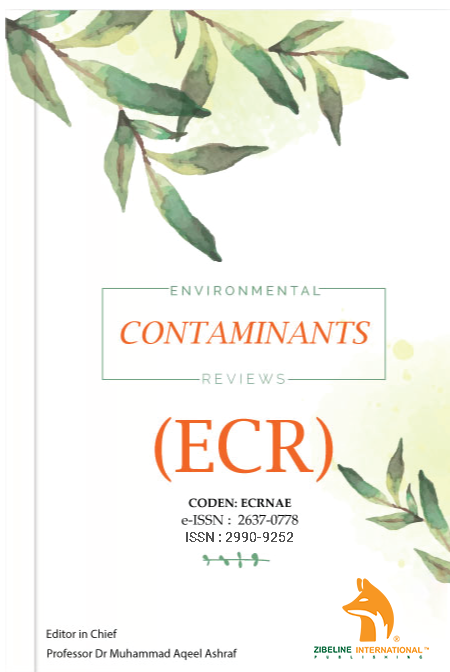
BIOCHEMICAL MECHANISMS OF CARCINOGENESIS: THE ROLE OF ENVIRONMENTAL POLLUTANTS IN CANCER DEVELOPMENT AND THERAPY
Journal: Environmental Contaminants Reviews (ECR)
Author: Nahida Nargis, Prabal Barua, Noor Mohammad and Md. Azizul Haque
This is an open access article distributed under the Creative Commons Attribution License CC BY 4.0, which permits unrestricted use, distribution, and reproduction in any medium, provided the original work is properly cited
Doi:10.26480/ecr.02.2025.66.77
ABSTRACT
Cancer remains one of the leading causes of death around the world. Its development is deeply rooted in a web of complex biochemical processes influenced by both inherited genetic traits and the environment we live in. Among the environmental influences, pollutants such as airborne toxins, heavy metals, pesticides, and industrial chemicals play a major role—not just in starting the disease, but also in making it worse over time. These harmful agents can trigger cancer by causing genetic mutations, changing the way genes function (without altering the DNA sequence itself), and setting off inflammatory reactions that create the perfect environment for tumors to grow. They don’t just stop there. These pollutants interfere with critical processes inside our cells—like DNA repair, how cells grow and divide, how they die off naturally (a process called apoptosis), and even how tumors create their own blood supply (angiogenesis). The direct damage of DNA, forming harmful structures called DNA adducts or breaking the DNA strands entirely. This leads to mutations in important genes that either drive cancer (oncogenes) or normally suppress it (tumor suppressor genes). Environmental toxins can trigger mutations that make standard treatments less effective, either by altering the drug’s target or by switching on the cell’s defense mechanisms, like enhanced DNA repair or epigenetic adaptation. This makes treatment less successful and increases side effects, especially in healthy tissues already compromised by pollutants. There’s also a growing interest in creating therapies that are more precisely targeted to the kinds of damage caused by environmental carcinogens. Promising strategies include therapies that can reverse epigenetic changes (epigenetic reprogramming), treatments based on antioxidants to counter oxidative stress, and small molecules that block harmful DNA repair or mutation pathways triggered by pollutants. Ultimately, beating environmentally driven cancer calls for an interdisciplinary approach—bringing together biochemical research, pharmacology, and environmental science. This broader, more connected view can help us better understand how pollutants contribute to cancer and guide us toward more personalized and effective treatments. The future of cancer care lies in therapies that are not only tailored to the patient’s genetic makeup but also take into account their environmental exposures. By addressing the unique molecular impacts of environmental carcinogens, we can improve survival rates, enhance quality of life, and develop better prevention strategies.
KEYWORDS
Cancer, biochemical processes, genetic mutations, epigenetic changes, environmental pollutants, airborne toxins, heavy metals, pesticides, industrial chemicals, DNA repair

